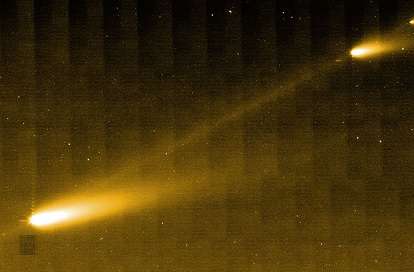Astronomers recall how they discovered source of dazzling December meteor shower known as Geminids

The beautiful Geminids meteor shower is due to light up the heavens this weekend, but the source of the enigmatic cosmic display had eluded stargazers for more than 120 years.
Although the popular astronomical event has been observed since the 1800s, its origins had long remained a mystery.
It was only discovered relatively recently, compared to other showers such as the Perseids, which were first documented in 36 AD and Leonids, which date back to 902 AD.
Then, in 1983, two University of Leicester astronomers—Dr. Simon Green and Dr. John Davies—were studying data from the infrared sensitive telescope on the Infrared Astronomical Satellite, IRAS, and discovered an asteroid with a very unusual orbit.
Originally designated 1983 TB, the comet was renamed 3200 Phaethon after the son of Greek Sun god Helios—an appropriate moniker as it orbits closer to the Sun than any other asteroid then known.
Shortly after the find, Harvard astronomer Fred Whipple was able to link the newly discovered rocky object, which is about three miles wide, with the Geminid meteors, and the mystifying source of the showers was revealed.
Now a Senior Lecturer in Planetary and Space Sciences at the Open University, Dr. Green—a PhD student at the time of Phaethon's discovery—said: "I was a PhD student at Leicester at the time. Professor Jack Meadows, my supervisor, had arranged for me to work on his proposed IRAS Fast Moving Object Survey for my thesis.
"The Rutherford Appleton Laboratory near Didcot operated the ground station and did the preliminary analysis of the data to check that everything was working correctly (the complete analysis and catalogues were produced at the Jet Propulsion Laboratory after the mission).
"My first task was to write the software to search among all the data rejected from the survey and try to identify potential fast-moving asteroids. It was based on code written by Brian Stewart at RAL to do the rejection."
Dr. Green said due to the mounting workload, more help was needed and Dr. Davies joined the team.
Dr. Green said: "When we realized that we would need to check the outputs of the code every 12 hours for the planned year of the mission, Jack bid for and obtained funding to employ a postdoc (John).
"One or both of John and I were at RAL for almost all the actual 10 months that IRAS operated before running out of liquid helium coolant.
"Much of the time we alternated time at RAL and I was the one who was around when Phaethon appeared.
"In fact, the previous weekend, on one of the rare times when neither of us could be there, there was another fantastic candidate that we had missed, and I was determined not to miss another—which was the reason why I telephoned Palomar.
"We had set up a system to telex observatories (this was pre-email and Internet days), but I didn't want it to be left lying on a desk somewhere.
"John and I 'shared' the discoveries we made—several comets including IRAS-Araki-Alcock, which was a naked-eye comet in summer 1983 as it flashed by the Earth, a few asteroids in addition to Phaethon, and the first-ever detection of a cometary dust trail.
"The end result of the survey was several papers, including one in Nature, and my PhD thesis."
Dr. Green went on to be Comet Halley UK Coordinator and also worked on several space missions including Cassini, Huygens, Stardust and Rosetta.
Dr. Davies moved to the Royal Observatory in Edinburgh in 1987 and then relocated to Hawaii in 1993, to join the Joint Astronomy Centre before returning to Edinburgh in 2001.
Professor Paul O'Brien, of the University of Leicester Department of Physics and Astronomy, said: "The Geminids are usually the brightest meteor shower of the year, sometimes reaching over 100 per hour.
"Finding the source of them was a great achievement and is a good example of how you can make valuable yet unexpected discoveries using spacecraft."
Provided by University of Leicester





















